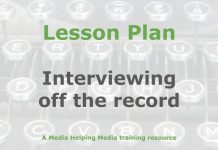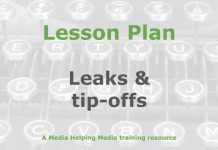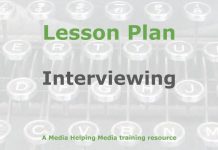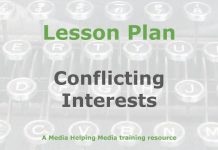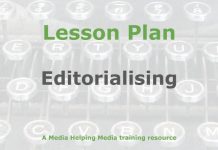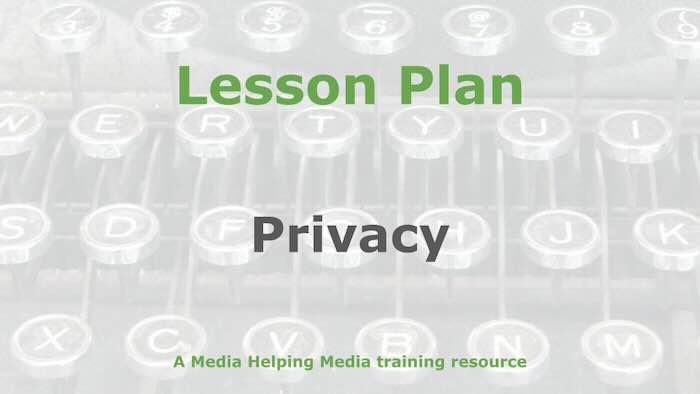 This lesson plan is designed to help journalists learn how to respect privacy while also being thorough as they investigate issues that are in the public interest.
This lesson plan is designed to help journalists learn how to respect privacy while also being thorough as they investigate issues that are in the public interest.
It’s based on the article ‘Respecting privacy as a journalist‘ which is published on Media Helping Media.
Learning objective
Students will evaluate scenarios where journalistic investigation may conflict with privacy, identifying when public interest justifies privacy intrusion. They will apply ethical guidelines to determine appropriate actions in these situations.
Student-facing objective: By the end of this lesson the student will be able to assess when it’s okay for journalists to investigate private matters if it’s considered to be important for informing the public.
Standards: Students will learn how to respect privacy while also being thorough as they investigate issues that are in the public interest.
Learning activities
Warm-up
Notice and wonder: Display a brief news clip or article headline related to a public interest story. Ask students, “What do you notice? What do you wonder?” Give them a few minutes to think and discuss with a partner. Then, have several students share their observations and questions. Record these for all to see. Guide the conversation towards questions about privacy and public interest, setting the stage for the lesson.
Direct instruction
- Introduce main concepts: Begin with a brief overview of the balance journalists must maintain between respecting privacy and serving the public interest.
- Define terms: privacy, public interest, and ethical guidelines. Use real-world examples, such as a journalist investigating corruption, to illustrate these concepts.
- Discuss ethical guidelines: Present the ethical guidelines journalists should follow when privacy and public interest conflict. Highlight the importance of fairness, respect, and transparency. Use a case study where a journalist had to decide whether to publish sensitive information. Discuss the decision-making process and the ethical considerations involved.
- Analyse scenarios: Provide students with several scenarios where journalistic investigation might intrude on privacy. For each scenario, ask students to identify the privacy concerns and evaluate whether the public interest justifies the intrusion. Encourage them to apply the ethical guidelines discussed. Facilitate a class discussion to explore different perspectives and reasoning.
Guided practice
Think, Pair, Share
- Think: Provide students with a scenario where a journalist must decide whether to publish a story involving private information. Ensure the scenario includes elements of public interest and potential privacy intrusion.
- Pair: Have students pair up to share their thoughts and reasoning. Encourage them to challenge each other’s perspectives and refine their arguments.
- Share: Invite pairs to share their conclusions with the class. Facilitate a discussion that highlights different viewpoints and ethical considerations.
- Reflection: Ask students to individually consider the scenario and jot down their thoughts on whether the journalist should proceed with the story. Encourage them to reference ethical guidelines discussed earlier.
- Discussion: Have students pair up to share their thoughts and reasoning. Encourage them to challenge each other’s perspectives and refine their arguments.
- Class sharing: Invite pairs to share their conclusions with the class. Facilitate a discussion that highlights different viewpoints and ethical considerations.
- Synthesise learning: Conclude by summarising the main points from the discussion, emphasising the importance of balancing privacy with public interest and adhering to ethical guidelines.
Independent practice
- Scenario analysis: Provide students with a set of scenarios where journalists face privacy vs. public interest dilemmas. Direct them to analyse each scenario independently, identifying privacy concerns and evaluating if public interest justifies intrusion. Encourage them to apply ethical guidelines discussed earlier.
- Reflection: Ask students to write a brief reflection on a scenario they analysed, focusing on their decision-making process and ethical considerations. Encourage them to consider how they would handle similar situations in real life.
Circulate to observe and support students as they work through these exercises.
Assignment
Ask students to answer these questions:
- What is one major factor that justifies a journalist intruding on someone’s privacy?
- How can journalists ensure they are respecting privacy while serving the public interest?
- What’s one question you still have from today’s lesson?
Here are some suggested answers:
- Suggested answer to Question 1: The public interest in exposing wrongdoing, such as corruption or crime.
- Suggested answer to Question 2: By following ethical guidelines, ensuring transparency, and obtaining necessary consent.
Teacher resources
Differentiation guide
- Advanced learners: Encourage deeper analysis by having them research and present a case study where journalistic privacy concerns were debated. Ask them to evaluate the outcomes and propose alternative approaches.
- Striving learners: Simplify scenarios and provide structured templates to guide their analysis. Pair them with peers for collaborative discussions to build confidence and understanding.
- Background reading: This lesson plan is based on the article ‘Respecting privacy as a journalist‘ which is published on Media Helping Media. We recommend you read the article before adapting this lesson for your own purposes.
Notable definitions
- Privacy: The right of individuals to keep their personal information and activities from being disclosed to the public without their consent.
- Public interest: The welfare or well-being of the general public, often used as a justification for actions that may intrude on individual privacy if they serve a greater good.
- Ethical guidelines: A set of principles that guide journalists in making decisions that balance the need for public information with the respect for individual privacy, ensuring fairness, respect, and transparency.
Required materials
- News clip or article headline: For the warm-up activity.
- Case study materials: Real-world examples of journalistic investigations.
- Scenario handouts: Printed or digital copies of scenarios for analysis.
- Journals: Notebooks or digital platforms for student reflections.
- Whiteboard/markers: For recording observations and discussion points.
- Projector/screen: To display news clips, headlines, and key concepts.
Lesson summary
- Warm-up
- Direct instruction
- Guided Practice
- Independent practice
- Assignment
The free teaching tools at the Khan Academy were used in the production of this lesson plan.


